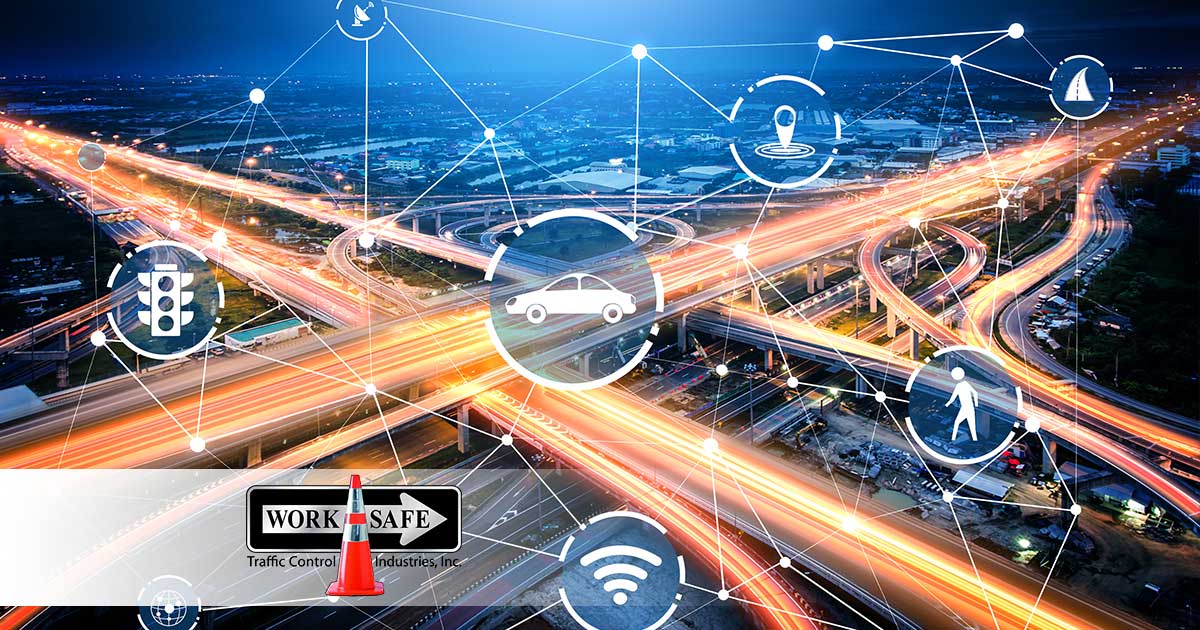
Work zones create hazards for drivers and workers. Installing smart work zone equipment mitigates the impacts of disrupted traffic patterns. Even the Manuel Uniform Traffic Control Devices (MUTCD) acknowledges under 6A.01.09 the positive impact on the safety of intelligent transportation systems (ITS) used in smart work zones. When work zones have properly integrated smart equipment coupled with standard traffic safety supplies, drivers and workers have better conditions. We hope you’ll contact us at Worksafe Traffic Control Industries to get your own setup ready today!
What is a Smart Work Zone?
Smart work zones have intelligent systems that help reduce traffic congestion and accidents. These systems use various types of equipment to collect real-time traffic information and automatically share reliable data with drivers.
Drivers entering a smart work zone will see warning signs of slower traffic and merges ahead. They may also see information about travel times and alternative routes before reaching the work zone. Having this data early allows some drivers to go on the alternative way and reduce overall traffic through the work area.
Equipment frequently used within smart work zones includes queue warning systems, variable post-mounted speed signs, detectors and sensors, dynamic lane merge signs, and real-time travel information.
Ways That Smart Work Zones Improve Traffic Safety
Smart work zone equipment has empirical data backing up its reputation for improving safety. Various studies over the years have examined how smart work zones affect travel times, fatalities, and non-fatal accidents. This information shows a clear reduction for all smart work zone equipment types. Integrating smart work zone equipment helped the number of crashes drop from 145,000 in 2016 to 102,000 in 2020.
Reduce Traffic by Encouraging Alternate Routes
Posting travel time or alternate route information encourages between 16% and 19% of drivers to bypass going through the work zone. Lowering the number of cars that pass through the work zone shrinks the opportunities for collisions between vehicles and workers.
Clear Incidents Faster for Better Traffic Flow
Another perk of gathering and using real-time information in smart work zones is enhancing the accuracy of information passing to traffic message channels (TMC). Drivers tuning into these channels get information that lets them avoid collisions in work zones. Less traffic through work zones makes the task of first responders easier. By improving TMC data, smart work zones reduce the response time to incidents within them by up to 45%. When responders reach incidents quicker, they can hasten to clear the scene and reopen traffic flow through the construction zone.
Keep Traffic Flowing Freely Through the Work Zone
Even with queue warnings, queue lengths can make drivers feel frustrated. Dynamic lane merging cuts the time in queues by 40%. Plus, aggressive merging, which can cause collisions, drops by 85%. Drivers through smart work zones with queue warnings and dynamic lane merges have safer trips with less frustration than in areas without these features.
Lower Overall Speed Through Work Zones
Slowing down traffic through work zones can save lives.
Speeding through work zones is a major source of fatalities. The Federal Highway Administration Work Zone Safety Program reports an increase in 2020 in the number of deaths in work zones caused by speeding. In 2019, 242 fatalities in work zones had speeding as a factor. This number reflected 32% of all deaths in work zones. By 2020, the quantity had risen to 287, accounting for 37% of work area deaths.
Variable speed limits (VSL) work to reduce overall speed differences through work zones. A study of this type of system in Minnesota showed up to 35% reductions in the speed differences through work zones during morning rush hour. Similarly, driver compliance with speed limits increased by up to 60%. Slowing down motorists can reduce the fatalities in work zones caused by speed.
Create Safer Construction Areas with Smart Work Zone Traffic Safety Supplies
Safer highway construction areas use quality traffic safety supplies, including smart work zone systems, to control speed, improve traffic flow, inform drivers, and reduce traffic volume. Worksafe Traffic Control Industries provides only the highest-quality MUTCD-compliant traffic safety supplies. With seven-day turnarounds, a competitive business model, a qualified government contractor, and a woman-owned operation, Work Safe is a standout in the field.

